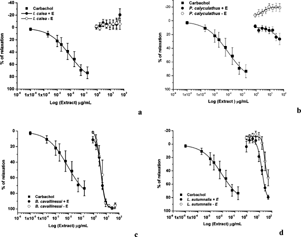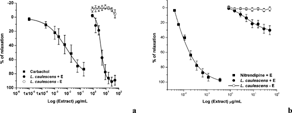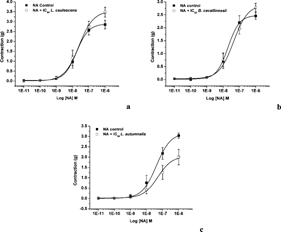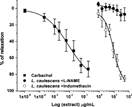Abstract
The vasorelaxant effect of methanol extracts (0.86–50 µg/ml) of Iresine calea, Psyttacanthus calyculathus. (DC.) G. Don, Laelia autumnalis. (Lex.) Lindley, Brickellia cavanillesii. (Cass.) Gray, and Lepechinia caulescens. (Ortega) Epling, plant species used in Mexican folk medicine for the treatment of hypertension and related diseases, were evaluated in isolated rat aortic rings. The extracts of I. calea. and P. calyculathus. did not show a vasorelaxant activity on norepinephrine-evoked contraction (NE, 1 × 10−7.5 M) in endothelium-intact (+ E) and endothelium-denuded (− E) rat aorta rings. On the other hand, L. autumnalis. and B. cavanillesii. induced a concentration-dependent and endothelium-independent relaxation on rat aorta. However, the methanol extract of L. caulescens. produced a significant vasodilator effect in a concentration-dependent and endothelium-dependent manner. In order to determine the mode of the vasorelaxant action evoked by L. caulescens., the extract was evaluated in the presence of L-NAME (inhibitor of nitric oxide synthase at 1 × 10−4 M) and indomethacin (inhibitor of cyclooxygenases at 1 × 10−5 M). Relaxation was blocked by L-NAME, indicating the extract vasodilating properties are endothelium mediated due to liberation of nitric oxide.
Introduction
Hypertension, defined as an elevation of systolic and/or diastolic blood pressure to above 140/90 mm Hg, is the most common cardiovascular disease. Hypertension is a major risk factor for endothelial dysfunction, metabolic syndrome, diabetes, renal dysfunction, congestive heart failure, coronary artery disease, and stroke (Sardana & Madan, Citation2003). These diseases are the most important causes of death in the world. Antihypertensive drugs influence arterial blood pressure at four effector sites: the resistance vessels, the capacitance vessels, the heart, and the kidney. Important classes of antihypertensive drugs are diuretics, sympatholytic drugs, vasodilators, calcium channel blockers, and angiotensin converting enzyme inhibitors (Gerber & Nies, Citation1991).
In Mexico, hypertension is one of the most important public health problems. In the year 2001, 441,004 deaths were registered and 81,248 were provoked by hypertension-related diseases (CIE-X, Citation1995), becoming the first cause of death (INEGI/SSA, Citation2002). On the other hand, the most highly used drugs for hypertension therapies are generally expensive and they have adverse effects; consequently, patients show low adherence and difficulty of the treatment (Gerber & Nies, Citation1991). In this context, the ancestral model of traditional Mexican medicine is a real choice as an alternative treatment of these diseases (Aguilar et al., Citation1994). In the state of Morelos, Mexico, 821 plant species have been registered as used in traditional medicine, and about 45 of them are employed as antihypertensives and for related diseases (Castillo & Monroy-Ortiz, Citation2000). A large number of these plants have not been yet studied in detail for their pharmacological activities.
The current work was designed to investigate the vasorelaxant properties of Iresine calea., Psyttacanthus calyculathus., Laelia autumnalis., Brickellia cavanillesii., and Lepechinia caulescens., as methanol extracts; these plants are used in Mexican folk medicine for the treatment of hypertension and related diseases (). Then, we also studied the possible mode of action of the active extract of L. caulescens..
Table 1 Botanical and common names of plant species screened, their vouchers specimen names, parts employed, and traditional medicinal uses (Castillo & Monroy-Ortiz, Citation2000).
Materials and Methods
Chemicals
Carbamoylcholine HCl (carbachol), norepinephrine HCl (NE), N.ω-Nitro-L-arginine methyl ester HCl (L-NAME), nitrendipine, and indomethacin were purchased from Sigma-Aldrich Co. (St. Louis, MO, USA). All other reagents were analytical grade from local sources.
Plant material
I. calea, P. calyculathus, L. autumnalis, L. caulescens., and B. cavanillesii. were collected in February 2004. Plant materials were obtained from their natural habitat in the State of Morelos, Mexico. They were collected and identified by Dr. P. Castillo-España and R. Ramírez, and all voucher specimens have been deposited at the “Centro de Educación Ambiental e Investigación Sierra de Huautla” HUMO-Herbarium, Cuernavaca, Morelos, Mexico. The details of medicinal plants along with their acquisition code numbers are listed in .
Preparation of the extracts
The collected air-dried plant material (100 g of aerial parts of each species) was ground into powder and extracted exhaustively by maceration at room temperature with MeOH. Solvent was replaced two times, and it was allowed to remain in contact with the plant material for 72 h. After filtration, the extracts were concentrated in vacuo. at 40°C, and the percentage yields were determined. To carry out the experiments, all extracts were dissolved in a mixture of dimethylsulfoxide:water (15:85).
Rat aorta ring tests
Thoracic aorta was removed from healthy male Wistar rats (250–350 g), maintained under standard laboratory conditions with free access to food and water. The rats were sacrificed by exposure to ether. All animal procedures were conducted in accordance with our Federal Regulations for Animal Experimentation and Care. (SAGARPA, NOM-062-ZOO-1999, México) and were approved by the Institutional Animal Care and Use Committee. The aorta was cleaned of adhering connective tissue and was cut into 3–5 mm length rings. In some rings, the endothelium was removed. Then, tissue segments were mounted by stainless steel hooks, under an optimal tension of 3 g, in 10 ml organ baths containing warmed (37°C) and oxygenated (O2/CO2, 19:1) Krebs solution (composition, mM: NaCl, 118; KCl, 4.7; CaCl2, 2.5; MgSO4, 1.2; KH2PO4, 1.2; NaHCO3, 25.0; EDTA, 0.026; glucose, 11.1, pH 7.4). Changes in tension were recorded by Grass-FT03 force transducers (Astromed, West Warwick, RI, USA) connected to a MP100 analyzer (BIOPAC Instruments, Santa Barbara, CA, USA), as previously described (Villalobos-Molina & Ibarra, Citation1996). After equilibration, rings were contracted by norepinephrine (NE) (1 × 10−7.5 M) or KCl (80 mM) and washed every 30 min for 2 h. The absence of endothelium was confirmed by the lack of a relaxing response to carbachol (1 × 10−6 M). After precontraction with NE, the test samples (extracts, vehicle, and positive control) were added to the bath in a volume of 100 µl; then cumulative concentration-response curves were obtained for each ring (0.86–50 µg/ml). In order to avoid fatigue of the arterial preparation, a 60-min recovery period was allowed between curves. The relaxant effect of extracts and positive controls (carbachol and nitrendipine) were determined by comparing the muscular tone of the contraction before and after the application of the test materials. Muscular tone was calculated from the tracings, using Acknowledge software (BIOPAC SYSTEM, Inc., Santa Barbara, CA, USA).
In order to establish the mode of action of active extracts, two set of experiments were performed:
When required by the experimental protocol, indomethacin (1 × 10−5 M) or L-NAME (1 × 10−4 M) were added to the organ bath and incubated during 15 min before contracting the arterial rings with NE (1 × 10−7.5 M). Then, active extract of L. caulescens. (100 µl) was added at different concentrations, and cumulative concentration-response curves were obtained.
The aortic rings were incubated with the active extracts of L. autumnalis. (15.54 ± 1.94 µg/ml), B. cavanillesii. (3.82 ± 0.29 µg/ml), and L. caulescens. (4.1 ± 0.53 µg/ml) during 15 min, then NE (100 µl) was added at different concentrations (1 × 10−11 to 1 × 10−6 M).
The effect of the active extracts in both experiments was determined and calculated as described.
Data analysis
All the results are expressed as the mean of six experiments ± SEM. Concentration responses curves (CRC) were plotted, and the experimental data from the CRC were adjusted by the nonlinear, curve fitting program (ORIGIN 6.0). The statistical significance (p < 0.05) of differences between means was assessed by an analysis of variance (ANOVA) (Bailey, Citation1995; Daniel, Citation2002).
Results
Methanol extracts of I. calea. and P. calyculathus. did not produce any vasorelaxant effect in aortic rings (+ E and − E) precontracted by NE ( and ; ).
Figure 1Effects of MeOH extracts from I. calea., P. calyculathus., B. cavallinesii., and L. caulescens. in aortic rings with (▪, E +) and without (○, E −) endothelium precontracted with NE 1 × 10−7.5 M. (a) MeOH extract of I. calea.; (b) P. calyculathus.; (c) B. cavallinessi.; (d) L. autumnalis.. Results are expressed as the means ± SEM of six experiments. p < 0.05.

Table 2 Relaxatory effects induced by methanolic extracts from L. autumnaliss, B. cavallinesii, L. caulescens, P. calyculathus, and I. calea. on the contraction induced by NE in endothelium-intact and denuded aorta rings.
Extracts from L. autumnalis. and B. cavanillesii. provoked inhibition of NE-evoked contractions in endothelium-intact and denuded aorta rings ( and ). The IC50 values for the relaxant response of active extracts of L. autumnalis. and B. cavanillesii. were similar in rings with a functional endothelium and in those without endothelium (). On the other hand, the methanol extract of L. caulescens. showed a significant relaxant effect in NE action on endothelium-intact aortic rings (IC50 = 4.10 ± 0.52 µg/ml, Emax = 90.17 ± 4.68%); however, in endothelium–denuded rings, no effect was observed (). Moreover, L. caulescens. produced a significant vasorelaxant effect on contraction evoked by KCl ().
Figure 2Effects of MeOH extract of L. caulescens. on aortic rings with (•, E +) and without (○, E −) endothelium, (a) precontracted with NE (1 × 10−7.5 M) and (b) precontracted with KCl (80 mM). Results are expressed as the mean ± SEM of six experiments. p < 0.05.

The active extracts from L. autumnalis. (15.54 µg/ml), B. cavanillesii. (3.82 µg/ml), and L. caulescens. (4.1 µg/ml)were evaluated on NE (1 × 10−11 to 1 × 10−6 M) cumulative concentration-effect curves on rat aorta rings (+ E). L. caulescens. and B. cavanillesii. did not show a rightward shift in the concentration-response curves ( and ) (L. caulescens.: IC50 = 1.75 × 10−8 ± 7.97 × 10−9 M, Emax = 2.88 ± 0.22 g for the first curve; and IC50 = 2.46 × 10−8 ± 1.13 × 10−8 M and Emax = 3.53 ± 0.30 g for the second curve; B. cavanillesii.: IC50 = 1.99 × 10−8 ± 9.29 × 10−9 M and Emax = 2.48 ± 0.15 g for the first curve; IC50 = 4.37 × 10−8 ± 1.77 × 10−8 M and Emax = 2.89 ± 0.23 g, for the second curve). However, L. autumnalis. induced a marked depression on the cumulative concentration-response curve for NE () (IC50 = 4.13 × 10−8 ± 1.83 × 10−8 M and Emax = 3.16 ± 0.2 g, for the first curve; IC50 = 5.07 × 10−8 ± 4.55 × 10−8 M and Emax = 2.05 ± 0.48 g for the second curve).
Figure 3Effects of IC50 of methanolic extract of (a) L. caulescens. (4.10 µg/ml), (b) B. cavanillesii. (3.82 µg/ml), and (c) L. autumnalis. (15.54 µg/ml) on NE cumulative concentration-effect curve (1 × 10−11 to 1 × 10−6 M) on rat aorta rings with endothelium. Each point represents the mean ± SEM of six aortic rings.

The vasorelaxant effect of methanol extract of L. caulescens. on endothelium-intact rat aorta rings, precontracted with NE, was also investigated in the presence of L-NAME (an inhibitor of nitric oxide synthase) and indomethacin (an inhibitor of cyclooxygenases). Pretreatment with L-NAME (1 × 10−4 M) produced a significant change of the response, and the vasorelaxant effect was markedly inhibited; on the contrary, pretreatment with indomethacin (1 × 10−5 M) did not show a significant influence in the extract vasodilator effect ().
Discussion
The methanol extracts of L. autumnalis. and B. cavanillessii. showed endothelium-independent vasodilator properties. B. cavanillesii. did not cause any rightward shift of the cumulative concentration-response curve for NE, indicating that vasorelaxant effect is not provoked by direct effect on adrenergic receptors (Vanhoutte, Citation2001). This effect is probably related to cGMP release (Ignarro, Citation1992). On the other hand, L. autumnalis. provoked a marked depression of the cumulative concentration-response curves for NE; this effect suggested that its action is linked to more than one mechanism. One of these might involve a cyclic nucleotide pathway (cGMP) (Ignarro, Citation1992), a second one could be associated with adrenoceptors blockade (Vanhoutte, Citation2001), and a third one could be related to intracellular Ca2+ release or opening of Ca2+ channels (Testai et al., Citation2005). Further experiments are in process to elucidate these alternatives.
The methanol extract of L. caulescens. produced a significant vasodilator effect in a concentration- and endothelium-dependent manner. This effect suggested that the response was caused by cyclooxygenase or nitric oxide synthase pathways (Vanhoutte, Citation2001). However, because vasorelaxation was blocked by L-NAME, while indomethacin did not antagonize the effect, endothelium-derived nitric oxide seems to be involved in extract's action (Moncada et al., Citation1997). Finally, L. caulescens. did not cause any rightward shift of the cumulative concentration-response curve for NE and produced a partial vasodilator effect on KCl-induced contraction, suggesting that the possible mode of action of this extract is related to the NO release (Aktan, Citation2004). In previous investigations, phytochemical analysis of L. caulescens. had led to the isolation of terpenoids and sterols (Delgado et al., Citation1992Citation1994), and biological evaluations demonstrated that L. caulescens. have antidiabetic (Román-Ramos et al., Citation2001) and spasmolytic (Rodríguez-López et al., Citation2003) activities. We consider that the vasodilator effect of L. caulescens. could be related to the presence of oleanolic (OA) and ursolic (UA) acids, triterpenoids isolated from this species in previous work (Delgado et al., Citation1994). Recently, these same compounds were isolated from other plants (Somova et al., Citation2003a) and were described as antihypertensive, antioxidant, antiatherosclerotic, and antihyperlipidemic agents (Somova et al., Citation2003aCitationb). However, the underlying mechanism involved in the antihypertensive effect of UA and OA is not clear.
Methanol extracts of I. calea. and P.. calyculathus. did not produce any vasorelaxant effect in aortic rings precontracted by NE. The results obtained with this experimental model do not allow us to reject the vasodilator properties of these plants; it would be necessary to carry out other experiments to confirm their use in Mexican medicinal folk. In addition, a chemical investigation of L. autumnalis. led to the isolation of N.-acetyl-D-galactosamine (Zenteno et al., Citation1995).
In conclusion, the results of this preliminary screening indicates the existence of active compounds in the crude methanol extracts of the assayed plants and supports the medicinal uses of these plants by the vasorelaxant effects observed. Currently, phytochemical studies of these medicinal plants are being conducted in order to obtain new or known chemical classes of vasodilator agents to understand their antihypertensive effects, which will allow us to recommend their use as an acceptable alternative in therapeutics.
Acknowledgments
This study was financed by a grant from CONACyT (SEP-2003-C02-43440/280) and PROMEP-SEP. Special thanks are due to Adrián Jiménez Cardoso, David Gómez Rodríguez, Itzell Gallardo, Daniel Godínez, Paula Espitia Reyes, and Jorge Vergara Galicia for technical assistance.
References
- Aguilar A, Camacho JR, Chino S, Jácquez P, López ME (1994): Herbario Medicinal del Instituto Mexicano del Seguro Social, México, Instituto Mexicano del Seguro Social, pp. 98, 99.
- Aktan F (2001): iNOS-mediated nitric oxide production and its regulation. Life Sci 75: 639–653. [CSA]
- Bailey NTJ (1995): Statistical Methods in Biology. Cambridge, Cambridge University Press, pp. 234–236.
- Castillo EP, Monroy-Ortíz C (2000): Plantas Medicinales Utilizadas en el Estado de Morelos, Cuernavaca, Morelos, México, Centro de Investigaciones Biológicas, Universidad Autónoma del Estado de Morelos, pp. 26, 34, 55, 154, 173.
- CIE-X (Clasificación Estadística Internacional de Enfermedades y Problemas Relacionados con la Salud), Décima Revisión (1995). Organización Panamericana de la Salud/Organización Mundial de la Salud.
- Daniel WW (2002): Bioestadística, Base para el análisis de las ciencias de la salud, 4th ed. México, Limusa, pp. 295–399.
- Delgado G, Hernández J, Chávez MI, Álvarez L, Gonzaga V, Martínez E (1994): Di- and triterpenoid acids from Lepechinia caulescens.. Phytochemistry 37: 1119–1121. [CROSSREF], [CSA]
- Delgado G, Sánchez E, Hernández J, Chávez MI, Álvarez L, Martínez E (1992): Abietanoid acids from Lepechinia caulescens.. Phytochemistry 31: 3159–3161. [CROSSREF], [CSA]
- Gerber JG, Nies AS (1991): Antihypertensive agents and the drugs therapy of hypertension. In: Goodman and Gilman's The Pharmacological Basis of Therapeutics, 8th ed. pp. 784–785.
- Ignarro LJ (1992): Haem-dependent activatin of cytosolic guanylate cyclase by nitric oxide: A widespread signal transduction mechanism. Biochem Soc T 41: 465–469. [CSA]
- INEGI/Secretaría de Salud (2002): Dirección general de información en salud. CONAPO, Proyecciones de la población de México, 2000–2050.
- Moncada S, Higgs A, Furchgott R (1997): XIV. International union of pharmacology nomenclature in nitric oxide research. Pharmacol Rev 49: 137–142. [PUBMED], [INFOTRIEVE], [CSA]
- Rodríguez-López V, Salazar L, Estrada S (2003): Spasmolytic activity of several extracts obtained from some Mexican medicinal plants. Fitoterapia 74: 725–728. [CROSSREF], [CSA]
- Román-Ramos R, Contreras-Weber CC, Nohpal-Grajeda G, Flores-Saenz JL, Alarcón-Aguilar FJ (2001): Blood glucose level decrease caused by extracts and fractions from Lepechinia caulescens. in healty and alloxan-diabetic mice. Pharm Biol 39: 317–321. [CSA]
- Sardana S, Madan AK (2003): Topological models for prediction of antihypertensive activity of substituted benzylimidazoles. J Mol Struct 638: 41–49. [CSA]
- Somova LI, Shode FO, Ramnanan P, Nadar A (2003a): Antihypertensive, antiaatherosclerotic and antioxidant activity of triterpenoids isolated from Olea europaea., subspecies africana. leaves. J Ethnopharmacol 84: 299–305. [PUBMED], [INFOTRIEVE], [CROSSREF], [CSA]
- Somova LO, Nadar A, Rammanan P, Shode FO (2003b): Cardiovascular, antihyperlipidemic and antioxidant effects of oleanolic and ursolic acids in experimental hypertension. Phytomedicine 10: 115–121. [PUBMED], [INFOTRIEVE], [CROSSREF], [CSA]
- Testai L, Silvio C, Ammar B, Luisa P, Vincenzo C, Martinotti E (2005): Vasorelaxant effects of the chloroformic crude extract of Bupleurum fruticosum. L. (Umbelliferae) roots on rat thoracic aorta. J Ethnopharmacol 96: 93–97. [PUBMED], [INFOTRIEVE], [CROSSREF], [CSA]
- Vanhoutte PM (2001): Endothelial adrenoceptors. J Cardiovasc Pharmacol 38: 796–808. [PUBMED], [INFOTRIEVE], [CROSSREF], [CSA]
- Villalobos-Molina R, Ibarra M (1996) α-Adrenoreceptors mediating contraction in arteries of normotensive and spontaneously hypertensive rats are of the α.1D or α.1A subtypes. Eur J Pharmacol 298: 257–263. [PUBMED], [INFOTRIEVE], [CROSSREF], [CSA]
- Zenteno R, Chavez R, Portugal D, Paez A, Lascurain R, Zenteno E (1995): Purification of a N-acetyl-D-galactosamine specific lectin from the orchid Laelia autumnalis.. Phytochemistry 40: 651–656. [PUBMED], [INFOTRIEVE], [CROSSREF], [CSA]
